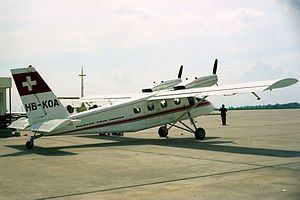Top speed 260 km/h Length 10 m | Wingspan 16 m | |
 | ||
The Pilatus PC-8D Twin Porter was a Swiss ten-seat light transport built by Pilatus Aircraft. The type did not go into production and only one was built.
Contents
Work on the Twin Porter started in 1966, it was a modified Pilatus PC-6 high-wing monoplane with the nose-mounted engine removed and two 290 hp Lycoming IO-540-GIB engines mounted on the wing leading edges. The prototype first flew on 28 November 1967. Only one aircraft was built as flight testing was halted in 1969.
Development
To keep development costs down, as many components as possible were adopted from the single-engine PC-6 Porter, such as the center fuselage, the wings and main landing gear. There was a new development of the forward fuselage, also with the tail and the arrangement of the propellers. The cabin was easily converted for various tasks. First drafts showed a motor assembly right and left of the fuselage nose, similar to the Dornier Do 28. A tandem arrangement of the engines like on the Dornier Wal above the fuselage, as with the earlier flying boats, was considered. In the final design, the engines were located very close, in front of the wings, to the fuselage with separate engine pylons. There was no fixed connection between the engines and the wings, but a gap as in a slat. With this arrangement, it was hoped to obtain favorable values for single-engined flight.
Flight testing
On 28 November 1967, the PC-8D prototype made its first flight. The results from more than a year of flight testing were not satisfactory, so they abandoned the project at the end of January 1969. Because of the lack of single-engine performance, approval by FAR23 was not possible. The PC-8D Twin Porter was presented also at the international air show in Paris. The only aircraft built was scrapped after the project.
Simultaneously, Pilatus began the development of the training aircraft PC-7 powered by a turboprop engine. This made it possible to retrofit existing piston-engined Pilatus Porters with turboprop engines, with minimal changes to the airframe. The desired higher power of the twin PC-8D was achieved with lower operating and maintenance costs. A PC-8 with twin turboprop engines was considered, but was abandoned due to lack of market demand.
Specifications
Data from Flight International
General characteristics
